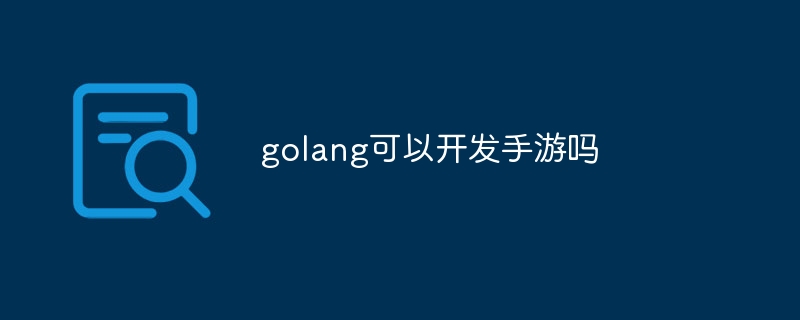
Golang can develop mobile games. Its advantages: 1. Rapid iteration, its compilation speed is very fast, and it can be tested and iteratively developed faster; 2. Concurrent processing, its concurrency model and goroutine mechanism enable concurrent tasks The writing and management have become simpler and more efficient; 3. Lightweight deployment, the executable file generated after compilation is smaller and has fewer dependencies, making the deployment and distribution of mobile game applications more convenient.

The operating environment of this article: Windows 10 system, go1.20 version, DELL G3 computer.
As a programmer, I am happy to answer your questions about using Go language (Golang) to develop mobile games. The following is my detailed answer to this question:
The Go language is an open source, statically typed programming language developed by Google. Its design goal is to provide a concise, efficient, and reliable programming language that is particularly suitable for building high-performance applications. Although the Go language is relatively new to the world of game development, it is already being used by an increasing number of developers to build mobile gaming applications.
First, let us take a look at some features of the Go language to understand whether it is suitable for mobile game development. Go language has the following characteristics:
Simple and easy to use: The syntax of Go language is concise and clear, making it easy to learn and use. It gets rid of some complex features, making the code easier to read and maintain.
Concurrency support: The Go language has built-in powerful concurrency support. Through the goroutine and channel mechanisms, concurrent programming can be easily realized. This is useful for parallel processing and multi-threaded operations in game development.
High performance: The compiler and runtime system of the Go language are optimized and have excellent performance. Its garbage collection mechanism and concurrency model make it excellent at handling large-scale game logic.
Cross-platform support: Go language can be compiled into machine code and supports multiple operating systems and architectures. This means you can develop once in Go and then deploy and run your mobile game app on different platforms.
Based on the above characteristics, the Go language has some advantages in mobile game development:
Fast iteration: The compilation speed of the Go language is very fast, which allows you to go faster conduct testing and iterative development. This is very helpful for rapid prototyping and frequent iterations in mobile game development.
Concurrency processing: Mobile game development usually involves processing a large number of concurrent tasks, such as game logic, network communication, rendering, etc. The concurrency model and goroutine mechanism of the Go language make the writing and management of concurrent tasks simpler and more efficient.
Lightweight deployment: The executable file generated after Go language compilation is smaller and has fewer dependencies, which makes the deployment and distribution of mobile game applications more convenient. In addition, the cross-platform support of the Go language also allows applications to run on multiple platforms, thereby expanding the audience scope.
Of course, there are also some challenges and limitations in using Go language for mobile game development:
The ecosystem is relatively small: Compared with other mainstream game development languages and engines, Go language games The development ecosystem is relatively small. While there are some excellent third-party libraries and frameworks available, the choices can be somewhat limited compared to other languages.
Limited graphics rendering support: There is no direct support for graphics rendering in the standard library of the Go language. However, there are some third-party libraries (such as Ebiten, Pixel, etc.) that can provide support for 2D graphics rendering, allowing you to build 2D mobile game applications.
3D game development is relatively weak: Compared with 2D game development, Go language’s support for 3D game development is relatively weak. Although there are some third-party libraries (such as G3N, Unity3D, etc.) that can provide support for 3D graphics rendering, compared with other specialized 3D game engines, the functions may be limited.
To sum up, the Go language has some advantages and limitations in mobile game development. If you have requirements for rapid iteration, concurrent processing, and cross-platform deployment, and have relatively low graphics rendering requirements, then the Go language is a good choice. But if you have higher requirements for 3D game development or a richer game development ecosystem, you may need to consider other more specialized game development languages and engines.
The above is the detailed content of Can golang develop mobile games?. For more information, please follow other related articles on the PHP Chinese website!




